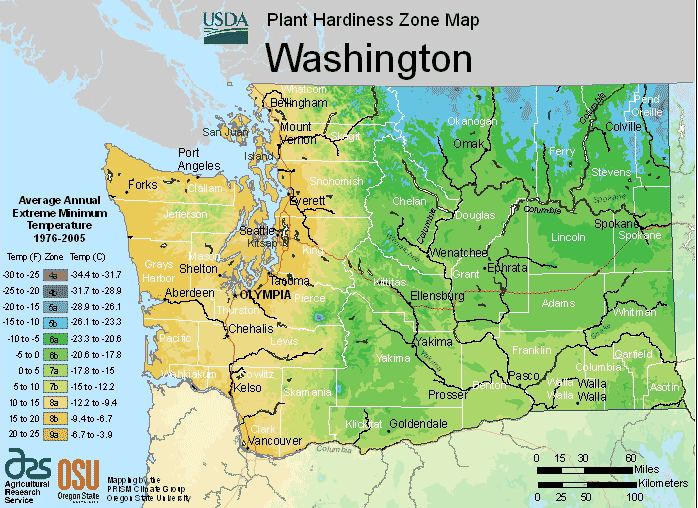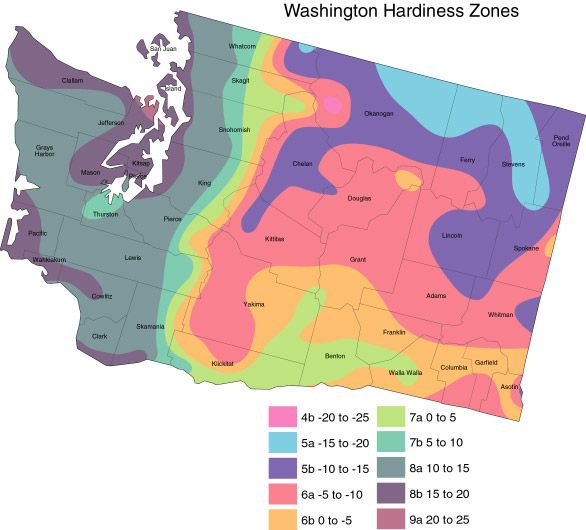
Table of Contents
Characteristics of Washington Planting Region

This area has warm, moist summers and gentle winters. Snow is rarely seen outside the mountains, but fog, clouds, and rainfall are experienced everywhere.
The eastern part of the state will have sweltering summers and frosty winters, with not much rain but plenty of sun.
In addition, much of the state is vulnerable to wildland fires, floods, strong storms, mudslides, and even quakes.
It is wise to determine the frost-free dates for your location before beginning, as the length of the growing season varies widely in the region.
Challenges of Growing in Washington
1. Diverse Climate
2. Extreme Weather
The Best Plants to Cultivate in Washington’s Planting Zone
Washington’s temperate climate and ample rainfall provide an ideal environment for a wide selection of flora. Here are some of the best plants to grow in Washington’s planting zone:
1. Rhododendrons (Rhododendron spp.): These stunning flowering shrubs are a hallmark of Washington gardens, renowned for their vibrant, showy blooms. With various sizes and colors available, Rhododendrons add a splash of beauty to landscapes and thrive in the state’s mild climate.
2. Ferns (Various genera): Washington’s lush forests and moist environments make it an excellent habitat for ferns. From the enchanting Maidenhair ferns to the robust Sword ferns, these shade-loving plants bring a touch of green elegance and add an air of tranquility to garden spaces.
3. Lavender (Lavandula spp.): Lavender’s aromatic fragrance and vibrant purple flowers make it a beloved addition to Washington gardens. With its affinity for well-drained soil and sunny locations, this drought-tolerant perennial thrives in the state’s drier regions, spreading delightful scents through the air.
4. Japanese Maples (Acer palmatum): Japanese Maples are treasured for their intricate foliage and graceful form. Whether it’s the classic crimson hues or the delicate green leaves, these small to medium-sized trees flourish in Washington’s temperate climate, adding a touch of sophistication to any landscape.
5. Tulips (Tulipa spp.): Nothing signifies the arrival of spring in Washington quite like the vibrant blooms of tulips. These colorful bulbs bring life and cheer to gardens and landscapes, with a wide array of varieties to choose from for a stunning spring display.
6. Hellebores (Helleborus spp.): Also known as Lenten Roses, Hellebores are early bloomers that add charm to the late winter and early spring garden. With their unique downward-facing flowers in hues of pink, white, and purple, they bring a delightful surprise during the awakening of spring.
7. Douglas Fir (Pseudotsuga menziesii): As a native conifer and an emblem of the Pacific Northwest, the Douglas Fir is an essential addition to Washington landscapes. These majestic evergreens provide year-round beauty and are valued for their timber as well.
8. Blueberries (Vaccinium spp.): Washington’s cool climate and acidic soils create an ideal environment for growing blueberries. These fruit-bearing shrubs offer not only delicious berries but also stunning foliage and beautiful fall colors.
9. Camellias (Camellia spp.): Camellias are renowned for their lush, glossy foliage and elegant flowers that bloom in winter and early spring. These evergreen shrubs add a touch of refinement to the garden and thrive in the milder regions of the state.
10. Salal (Gaultheria shallon): This native evergreen shrub is a staple of Washington gardens. With its glossy leaves and bell-shaped flowers, Salal is not only attractive but also provides habitat and food for native wildlife.
To ensure successful gardening in Washington, it’s essential to consider the specific conditions of the region. In wetter coastal areas, adequate drainage and site selection become crucial, while in drier eastern regions, water-conserving techniques are beneficial.
Mulching and proper watering practices help maintain soil moisture and protect plants during dry spells. Regular pruning and maintenance are essential to keep plants healthy and promote optimal growth.
In conclusion, Washington’s planting zone offers a wealth of plant choices for gardeners seeking to create flourishing landscapes. From the vibrant blooms of rhododendrons and tulips to the elegance of Japanese maples and camellias, the best plants for Washington thrive in the state’s temperate climate and bring a touch of natural beauty to any outdoor space. By selecting plants that complement the unique features of the region and providing appropriate care, gardening enthusiasts can enjoy lush and colorful gardens that celebrate the natural wonders of the Evergreen State.
FAQ
What climate zone is Seattle WA?
Seattle’s climate is temperate, categorized under the Warm-Summer Mediterranean type (Köppen: Csb) or sometimes the oceanic zone (Trewartha: Do).
What is my growing zone in Washington state?
The USDA created hardiness zones based on the average minimum winter temperature for a 30-year span. Most of western Washington is in USDA zones 7b-8b, with the average low ranging from 5-20°F.
What planting zone is the Pacific Northwest?
Much of the Pacific Northwest falls in zones 6 – 9, with some areas in zone 5. This is critical information for gardening; make sure to select plants that flourish in your region by comparing the zone info on the back of the seed packet with what you know about your climate.
What zone is Portland Oregon for planting?
Zone 8b is a region characterized by a moderate climate with warm winters and mild summers. This area is ideal for various plants and trees that may not survive in colder climates.
Zone 8b has a temperate climate with mild winters and warm summers, making it suitable for plants and trees that cannot handle colder temperatures.
What zone is Seattle Washington State?
Seattle, Washington is categorized in Hardiness Zones 8b and 9a by the USDA.
